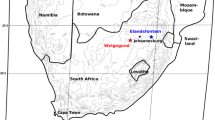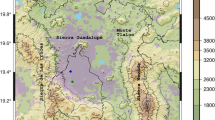Abstract
Airborne, light detection and ranging (lidar) backscatter observations of the convective boundary layer from the International H2O Project (IHOP) in 2002 are analysed to study the structure of the transition zone; the backscatter gradient between the convective boundary layer and free atmosphere. A new mathematical algorithm is developed and used to extract high-resolution (15 m) transition-zone boundaries from 6,500 km (flight legs) of airborne observations. The cospectra of transition-zone boundaries and its thickness indicate that thickness changes occur from boundaries moving in opposite directions (vertically) at small wavelengths (<1 km), while at longer wavelengths (>1 km) both boundaries move coherently, with the lower boundary changing altitude more rapidly. Daily probability distributions of the transition-zone thickness are positively skewed with a mode of 60 m. The structure of the transition zone shows no dependence on the “overall” Richardson number, unlike the entrainment zone. This study provides the first quantitative characterization of the structure of the instantaneous transition zone, a contribution towards an improved understanding of convective boundary-layer entrainment.
Similar content being viewed by others
References
Ayotte KW et al (1996) An evaluation of neutral and convective planetary boundary layer parameterizations relative to large eddy simulations. Boundary-Layer Meteorol 79: 131–175
Boers R (1989) A parameterization of the depth of the entrainment-zone. J Appl Meteorol 28: 107–111
Boers R, Eloranta EW (1986) Lidar measurements of the atmospheric entrainment-zone and the potential temperature jump across the top of the mixed layer. Boundary-Layer Meteorol 34: 357–375
Boers R, Eloranta EW, Coulter RL (1984) Lidar observations of mixed layer dynamics: tests of parameterized entrainment models of mixed layer growth rate. J Clim Appl Meteorol 23: 247–266
Brooks IM (2003) Finding boundary layer top: application of a wavelet covariance transform to lidar backscatter profiles. J Atmos Ocean Technol 20: 1095–1105
Brooks IM, Fowler AM (2007) A new measure of entrainment-zone structure. Geophys Res Lett 34: L16808
Chen F, Manning KW, LeMone MA, Trier SB, Alfieri JG, Roberts R, Tewari M, Niyogi D, Horst TW, Oncley SP, Basara JB, Blanken PD (2007) Description and evaluation of the characteristics of the NCAR high-resolution land data assimilation system. J Clim Appl Meteorol 46: 694–713
Conzemius RJ, Fedorovich E (2006) Dynamics of sheared convective boundary layer entrainment. Part 1: methodological background and large-eddy simulations. J Atmos Sci 63: 1151–1178
Davis KJ, Lenschow DH, Oncley SP, Kiemle C, Ehret G, Giez A, Mann J (1997) Role of entrainment in surface-atmosphere interactions over the boreal forest. J Geophys Res 102: 29219–29230
Davis KJ, Gamage N, Hagelberg CR, Kiemle C, Lenschow DH, Sullivan PP (2000) An objective method for deriving atmospheric structure from airborne lidar observations. J Atmos Ocean Technol 17: 1455–1467
Deardorff JW, Willis GE, Stockton BH (1980) Laboratory studies of the entrainment-zone of a convectively mixed layer. J Fluid Mech 100: 41–64
Ellison TH, Turner JS (1959) Turbulent entrainment in stratified flows. J Fluid Mech 6: 423–448
Flamant C, Pelon J, Flamant P, Durand P (1997) Lidar determination of the entrainment-zone thickness at the top of the unstable marine atmospheric boundary layer. Boundary-Layer Meteorol 83: 247–284
Fedorovich E, Conzemius R, Mironov D (2004) Convective entrainment into a shear-free, linearly stratified atmosphere: bulk models reevaluated through large eddy simulations. J Atmos Sci 61: 281–295
Hageli P, Steyn DB, Strawbridge KB (2000) Spatial and temporal variability of mixed-layer depth and entrainment-zone thickness. Boundary-Layer Meteorol 97: 47–71
Kaimal JC, Wyngaard JC, Izumi Y, Cote OR (1972) Spectral characteristics of surface-layer turbulence. Q J Roy Meteorol Soc 98: 563–589
Kang SL, Davis KJ, LeMone M (2007) Observations of the ABL Structures over a Heterogeneous Land Surface during IHOP_2002. J Hydrometeorol 8: 221–244
Kato H, Phillips OM (1969) On the penetration of a turbulent layer into stratified fluid. J Fluid Mech 37: 643–655
Kiemle C, Ehret G, Giez A, Davis KJ, Lenschow DH, Oncley SP (1997) Estimation of boundary layer humidity fluxes and statistics from airborne differential absorption lidar (DIAL). J Geophys Res 102: 29189–29203
Kiemle C, Brewer WA, Ehret G, Hardesty RM, Fix A, Senff C, Wirth M, Poberaj G, LeMone M (2007) Latent heat flux profiles from collocated airborne water vapour and wind lidars during IHOP_2002. J Atmos Ocean Technol 24: 627–639
Kunkel KE, Eloranta EW, Shipley ST (1977) Lidar observations of the convective boundary layer. J Appl Meteorol 16: 1306–1311
LeMone MA, Chen F, Alfieri JG, Cuenca RH, Hagimoto Y, Blanken P, Niyogi D, Kang S, Davis K, Grossman RL (2007) NCAR/CU surface, soil, and vegetation observations during the International H2O Project 2002 field campaign. Bull Am Meteorol Soc 88: 65–81
Melfi SH, Sphinhirne JD, Chou SH, Palm SP (1985) Lidar observations of the vertically organized convection in the planetary boundary layer over the ocean. J Clim Appl Meteorol 24: 806–821
Moeng CH, Sullivan PP, Stevens B (1999) Including radiative effects in an entrainment rate formula for buoyancy-driven PBLs. J Atmos Sci 56: 1031–1049
Otte MJ, Wyngaard JW (2001) Stably stratified interfacial-layer turbulence from large-eddy simulation. J Atmos Sci 58: 3424–3442
Pino D, Arellano J, Duynkerke PG (2003) The contribution of shear to the evolution of a convective boundary layer. J Atmos Sci 60: 1913–1925
Poberaj G, Fix A, Assion A, Wirth M, Kiemle C, Ehret G (2002) Airborne all-solid-state DIAL for water vapour measurements in the tropopause region: system description and assessment of accuracy. Appl Phys B 75: 165–172
Reen BP (2007) Data assimilation strategies and land-surface heterogeneity effects in the planetary boundary layer. Doctoral Dissertation, Penn State University, 246 pp
Stevens B, Moeng CH, Sullivan PP (1999) Large-eddy simulations of radiatively driven convection: sensitivities to the representation of small scales. J Atmos Sci 56: 3963–3984
Steyn DG, Baldi M, Hoff R (1999) The detection of mixed layer depth from lidar backscatter profiles. J Atmos Ocean Technol 16: 953–959
Stull RB (1988) An introduction to boundary-layer meteorology. Kluwer Academic, Norwell, MA, pp 666
Sullivan PP, Moeng CH, Stevens B, Lenschow DH, Mayor SD (1998) Structure of the entrainment-zone capping the convective atmospheric boundary layer. J Atmos Sci 55: 3042–3064
Turner JS (1968) The influence of molecular diffusivity across a density interface. J Fluid Mech 33: 639–656
Weckwerth TM, Parsons DB, Koch SE, Moore JA, LeMone MA, Demoz BB, Flamant C, Geerts B, Wang J, Feltz WF (2004) An overview of the international H2O project (IHOP_2002) and some preliminary highlights. Bull Am Meteorol Soc 85: 253–277
Wyngaard JC (2009) Turbulence in the atmosphere, Vol. 1. Cambridge University Press, 408 pp
Author information
Authors and Affiliations
Corresponding author
Electronic Supplementary Material
The Below is the Electronic Supplementary Material.
Rights and permissions
About this article
Cite this article
Grabon, J.S., Davis, K.J., Kiemle, C. et al. Airborne Lidar Observations of the Transition Zone Between the Convective Boundary Layer and Free Atmosphere During the International H2O Project (IHOP) in 2002. Boundary-Layer Meteorol 134, 61–83 (2010). https://doi.org/10.1007/s10546-009-9431-1
Received:
Accepted:
Published:
Issue Date:
DOI: https://doi.org/10.1007/s10546-009-9431-1




